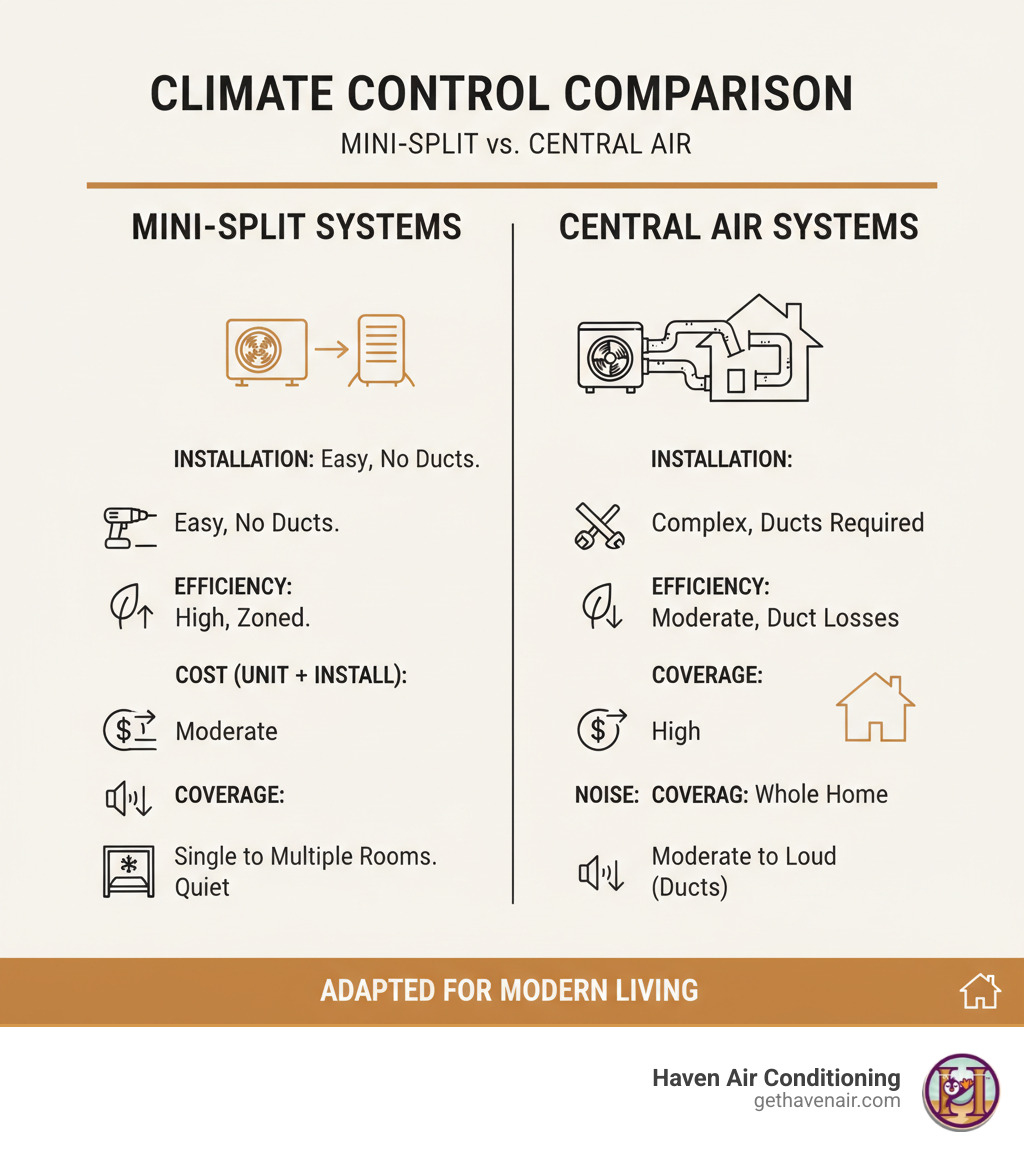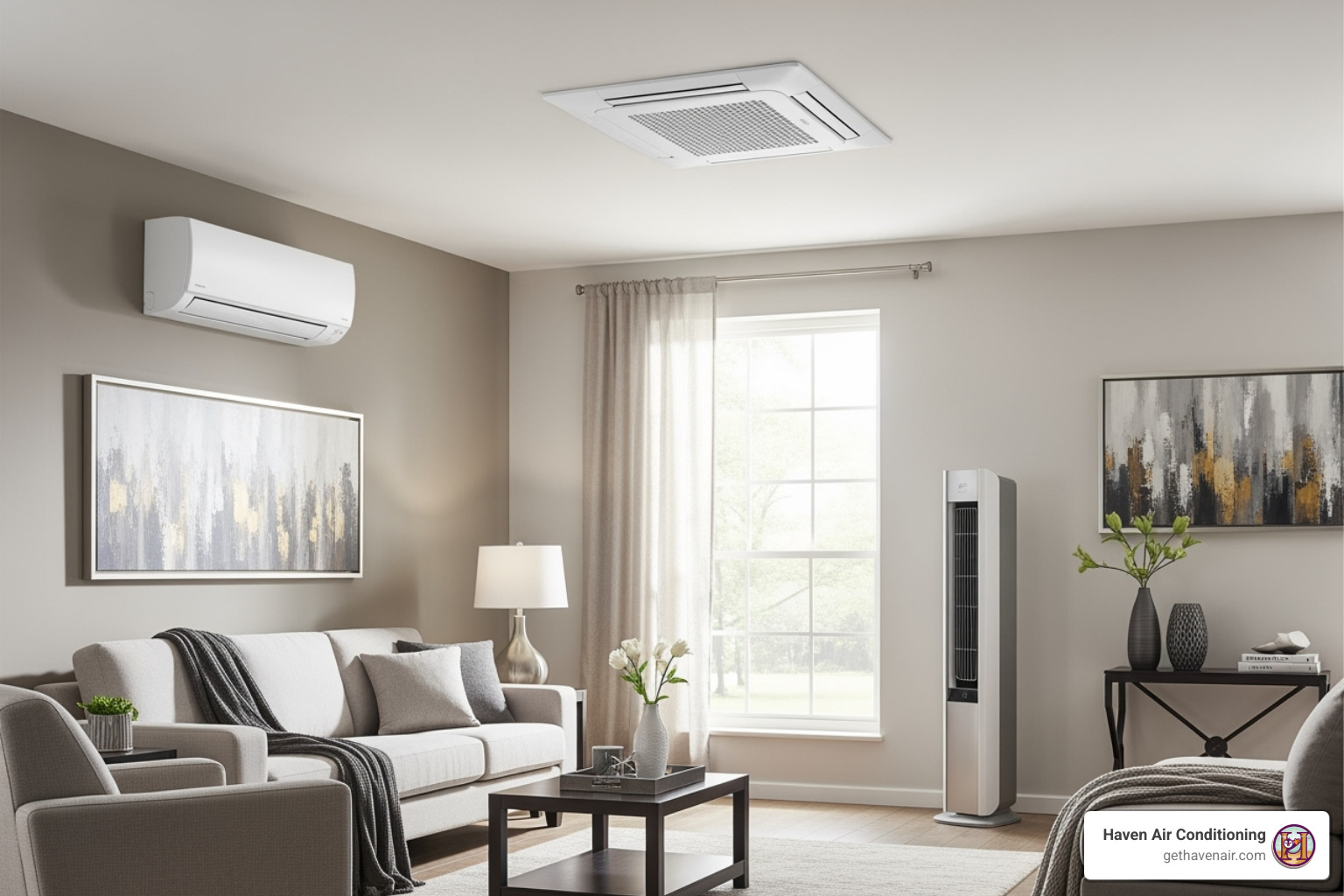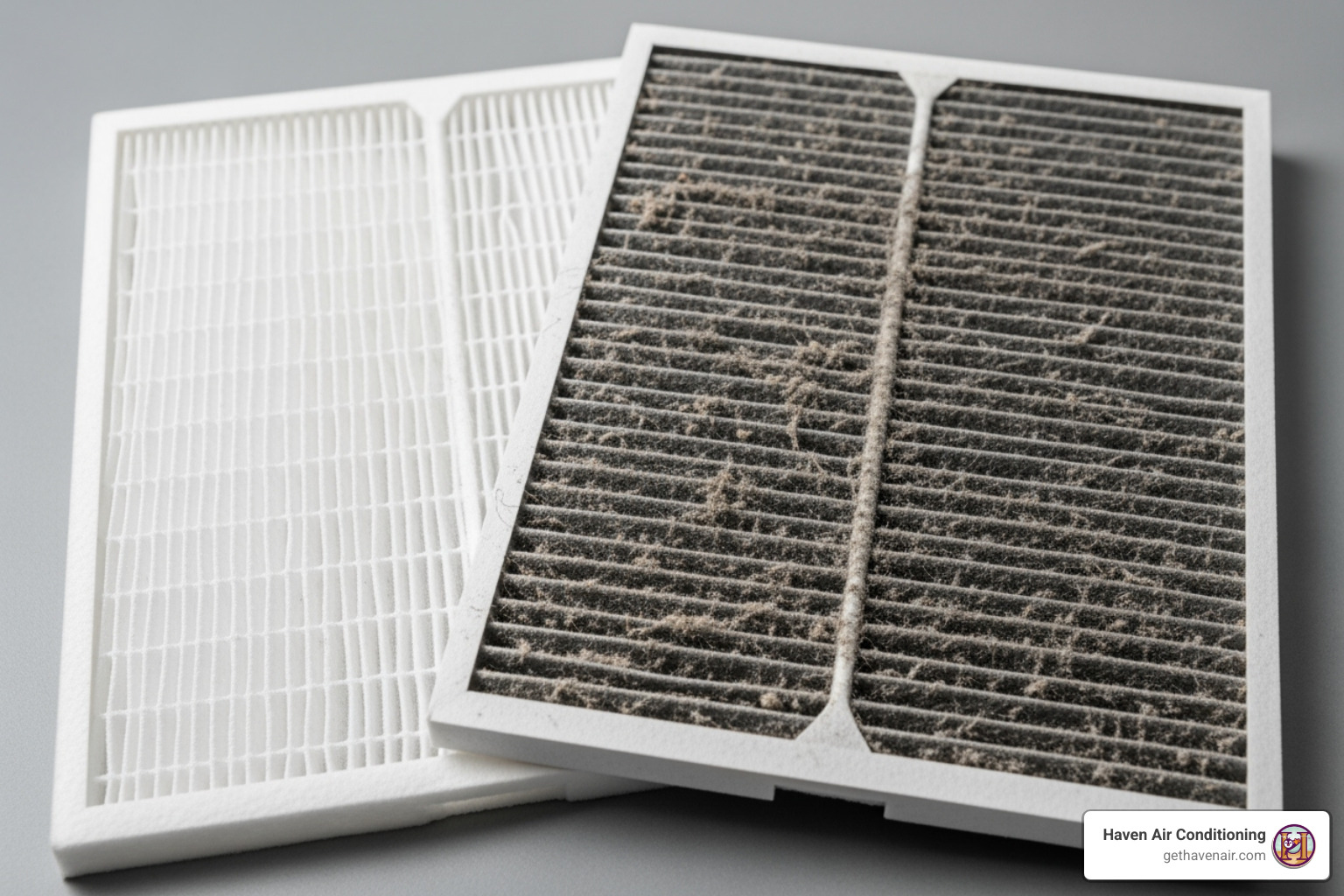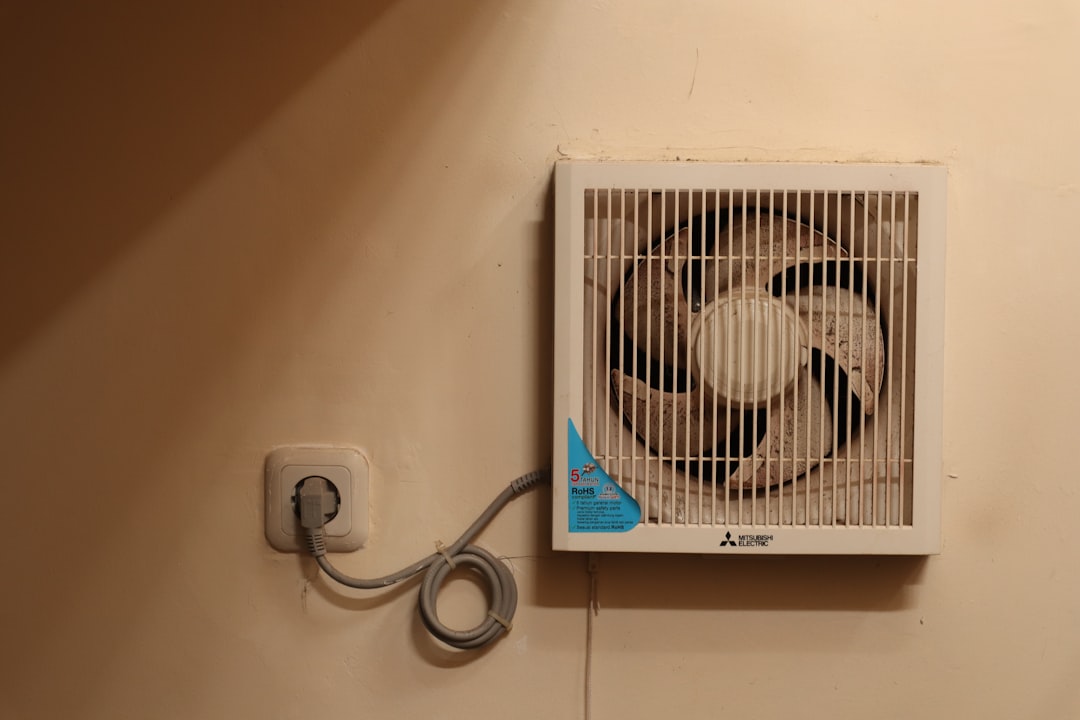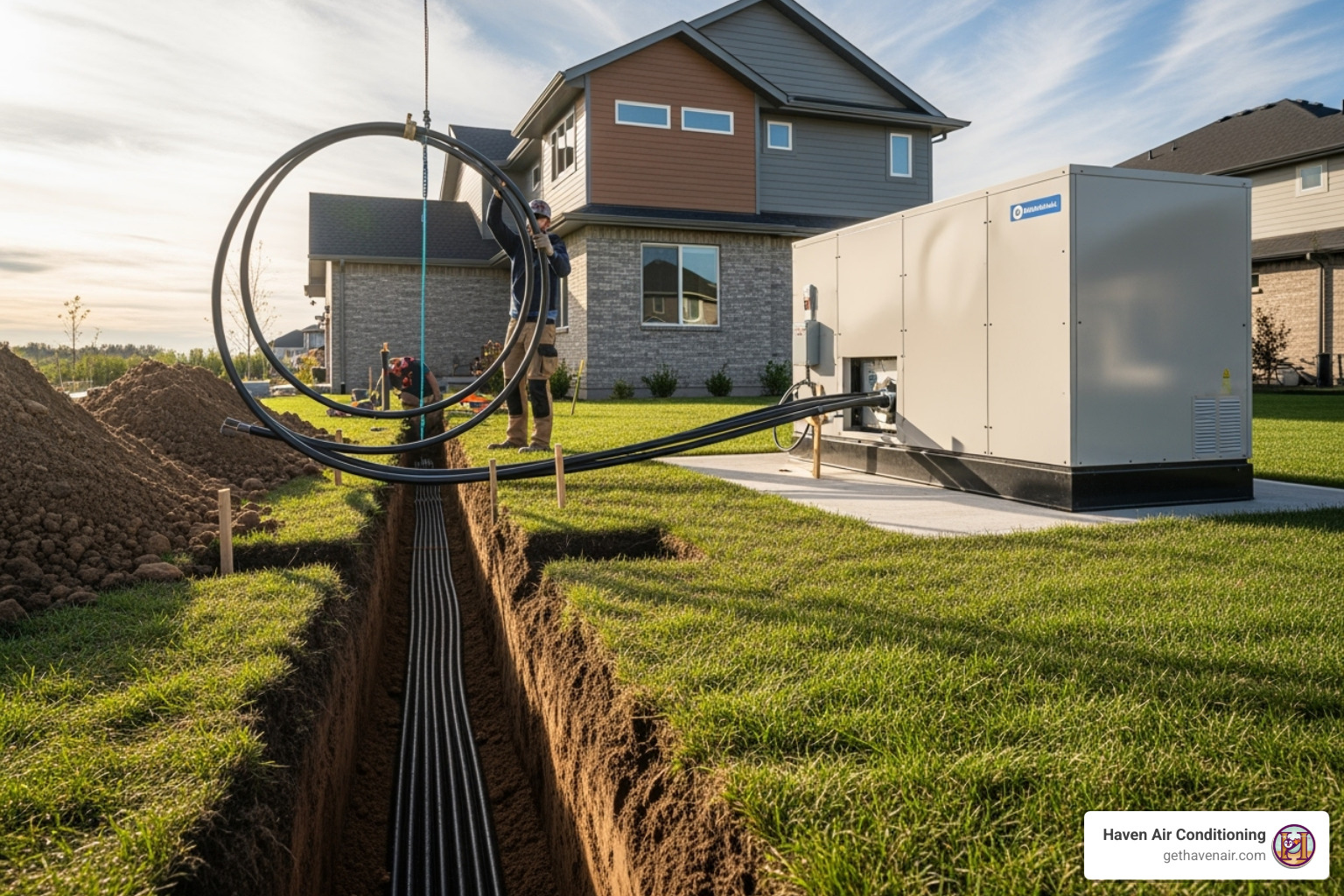Understanding Mini-Split Systems: Your Complete Guide
Mini splits are ductless heating and cooling systems that offer efficient climate control for individual rooms or zones. For Orange County homeowners facing issues like hot spots or aging HVAC systems, mini splits provide a flexible and efficient upgrade.
A mini split is a two-part system with an outdoor compressor/condenser connected to one or more indoor air-handling units. They work by transferring heat via refrigerant lines that run through a small wall opening. Their key benefit is the lack of ductwork, which can prevent up to 30% of the energy loss found in traditional systems. This makes them ideal for room additions, older homes without ducts, and any space where ductwork is impractical. With proper maintenance, they typically last 10-15 years.
Mini splits are popular in Orange County for solving inconsistent temperatures and high energy bills, especially in home additions or older homes. For expert guidance on HVAC solutions in Anaheim, CA and professional installation services, Haven Air Conditioning can help determine if a mini-split is right for you.
How Mini-Split Systems Work
Mini splits offer an efficient alternative to traditional HVAC through a simple design. The system consists of an outdoor unit (with the compressor and condenser) and one or more indoor air handlers, connected by a slim conduit. This conduit, containing power cables, refrigerant lines, and a condensate drain, only requires a small three-inch hole in the wall, eliminating the need for bulky ductwork.
The system cools your home by pulling warm air across the indoor unit’s cold evaporator coil. Refrigerant absorbs the heat, travels to the outdoor unit, and releases the heat outside. The process is then reversed for heating, as the system extracts heat from the outdoor air and moves it inside. This heat pump technology provides year-round comfort from a single system. For professional installation of Ductless AC systems, Haven Air Conditioning’s certified team ensures optimal performance.
Key Components Explained
A mini split system’s efficiency comes from its core components working in harmony.
- The outdoor compressor pressurizes the refrigerant (a specialized fluid like R-410A) to enable heat transfer, while the condenser coil releases that heat outdoors.
- The indoor evaporator coil absorbs heat from your room’s air, and a quiet blower fan circulates the newly conditioned air.
- A power cable runs the system, and a condensate drain line removes moisture collected during the cooling process.
The Advantage of Inverter Technology
Modern mini splits use inverter technology, which features a variable-speed compressor. Unlike traditional systems that are either fully on or off, an inverter-driven compressor adjusts its speed to precisely match the heating or cooling demand. This is a game-changer for several reasons:
- Energy Efficiency: It uses only the necessary power, avoiding energy-wasting cycles. ENERGY STAR certified models can use up to 60% less energy than standard electric heating.
- Consistent Temperature: It eliminates uncomfortable temperature swings by making continuous, minor adjustments.
- Quiet Operation: The compressor runs at lower, quieter speeds for longer periods, making it barely noticeable.
- Reduced Wear and Tear: Smoother operation extends the system’s lifespan.
This technology makes mini splits a smart choice for Orange County homeowners seeking to upgrade their heating and cooling.
Advantages and Disadvantages of Mini Splits
Mini splits offer a unique set of advantages and considerations. Understanding both sides helps you make an informed decision for your Orange County home.
Key Advantages Over Traditional Systems
- No Ductwork Required: Installation is minimally invasive, requiring only a small three-inch hole. This is ideal for older homes or additions where installing ducts would be a major renovation.
- Reduced Energy Consumption: By eliminating ducts, you avoid the 30%+ energy loss common in ducted systems. This leads to significant savings on utility bills.
- Individual Room Temperature Control: Zoned comfort allows you to set different temperatures for different rooms, ending thermostat debates. Each indoor unit has its own control. Learn more about Zone Control Benefits with Mini Split AC.
- Quiet Performance: The noisy components are outside, while indoor units operate at whisper-quiet levels, often around 19 decibels.
- Flexible Installation: Mini splits are perfect for room additions, converted garages, and home offices. With various indoor unit styles (wall-mounted, ceiling cassettes), they fit any home’s aesthetic. See examples in Space Saving Ductless AC in Modern Homes.
- Improved Indoor Air Quality: Air is filtered at the point of delivery, and the absence of ducts prevents the circulation of accumulated dust and allergens.
Potential Downsides and Considerations
- Aesthetics: The indoor units are visible on your wall or ceiling. While designs are sleek, they aren’t invisible like ducted vents. Strategic placement is key, as discussed in Ductless AC Placement Maximizes Home Comfort.
- Proper Sizing and Placement: This is critical for performance. An incorrectly sized system will be inefficient and ineffective. Professional installation is essential to get this right.
- Regular Filter Maintenance: Each indoor unit has a filter that needs to be cleaned monthly during heavy use. This is more frequent than with a central system.
- Whole-Home Coverage: In larger homes, multiple indoor units are needed to condition every space, which increases their visual presence.
- Air Filtration: While the filtration is good, some central HVAC systems can be fitted with more advanced HEPA filters. We can discuss additional solutions if you have severe allergies.
The Ultimate Guide to Choosing Your Mini Splits System
Choosing the right mini splits system is about matching the unit to your home’s specific needs. Key factors include the size of the space, your home’s electrical system, and the unit’s energy efficiency. A system that is too small will struggle to keep up, while an oversized one will cycle inefficiently. A more efficient system may have a higher upfront cost but will save you money on utility bills over time. For help with this crucial step, see our guide on Proper Sizing for Home AC Split Mini Systems.
Types of Mini Splits: Single-Zone vs. Multi-Zone
- Single-Zone Systems: This setup connects one outdoor unit to one indoor unit. It’s the perfect solution for a single problem area, like a home office, a new addition, or a converted garage, providing targeted and efficient comfort.
- Multi-Zone Systems: One powerful outdoor unit can connect to two or more indoor units. Each indoor unit has its own thermostat, allowing you to create customized temperature zones throughout your home. This is ideal for whole-home comfort without ductwork or for addressing several problem areas at once. You can learn more about how this works in our guide to 3 Zone Mini Split AC and Heat.
Understanding Energy Efficiency Ratings
When comparing mini splits, you’ll see several efficiency ratings. Here’s what they mean:
- SEER (Seasonal Energy Efficiency Ratio): Measures cooling efficiency over a whole season. A higher SEER means greater energy savings during Orange County’s long cooling season.
- EER (Energy Efficiency Ratio): Measures cooling efficiency at peak temperature (95°F), showing how the system performs on the hottest days.
- HSPF (Heating Seasonal Performance Factor): Measures heating efficiency over a winter season. A higher HSPF means more warmth for less energy.
In short, higher ratings mean lower operating costs. Look for ENERGY STAR certified mini splits, which meet strict EPA efficiency guidelines and can use up to 60% less energy than older systems. These models are guaranteed to deliver real savings. We encourage homeowners to learn more about ENERGY STAR® certified products to make an informed decision.
Installation, Maintenance, and Troubleshooting
Proper installation and care are key to getting the most out of your mini splits system, ensuring reliable comfort for 10-15 years or more.
The Installation Process
Compared to traditional HVAC, mini splits installation is refreshingly simple and non-disruptive. The process involves:
- Drilling a small, three-inch opening in an exterior wall.
- Mounting the indoor air handler on an interior wall or ceiling.
- Placing the outdoor compressor unit on a stable, level surface outside.
- Connecting the two units with a conduit containing refrigerant lines, power cables, and a drain line.
There’s no major construction or ductwork installation, making it an ideal solution for any home. However, professional installation is crucial. Tasks like system sizing, refrigerant charging, and electrical connections require certified expertise to ensure safety, efficiency, and longevity. Haven Air Conditioning’s technicians have the training to install your system correctly the first time. Explore our Cooling and Aircon: Ductless Cooling services for more information.
Maintenance and Troubleshooting for Your Mini Splits
Regular maintenance keeps your system running smoothly. Homeowners should clean the indoor unit’s air filters monthly during heavy use to ensure good airflow and air quality. It’s also important to keep the area around the outdoor unit clear of leaves and debris.
For more complex issues, professional service is recommended. An annual tune-up by a certified technician, who will clean coils, check refrigerant levels, and test electrical connections, can prevent costly repairs.
Be aware of common warning signs:
- Inadequate Cooling/Heating: Could be a dirty filter, but may also indicate low refrigerant or a dirty outdoor coil.
- Unusual Noises: Rattling or buzzing can signal loose parts or motor issues. Our guide on Mini Split AC Making Unusual Sounds can help.
- Water Leaks: A clogged condensate drain line is the usual culprit.
- Musty Odors: Often indicates mold or mildew buildup that requires professional cleaning. See our Odors from AC Mini Split Home Guide for details.
- Ice on the Unit: Usually caused by restricted airflow (dirty filter) or low refrigerant. Turn the system off and call a professional.
- Error Codes: Consult your manual or our guide to Decoding Mini Split AC Error Codes to understand the issue.
Promptly addressing these Warning Signs a Ductless AC Needs Attention will keep your system efficient and reliable.
Frequently Asked Questions about Mini-Split Systems
We often get questions from Orange County homeowners about the versatility of mini splits. Here are answers to some of the most common ones.
Are mini-split systems suitable for cold climates?
Yes, absolutely. Modern mini split heat pumps feature advanced technology that allows them to efficiently extract heat from outdoor air even in very low temperatures. Some high-performance models can operate effectively in temperatures as low as -22°F. For Orange County’s mild winters, this means a mini split can easily serve as your sole heating and cooling system year-round, offering significant energy savings over traditional electric heating.
How do mini-split systems contribute to indoor air quality?
Mini splits improve indoor air quality in two key ways. First, they eliminate ductwork, which can accumulate dust, pollen, and mold over time. Conditioned air is delivered directly into your room without passing through potentially contaminated ducts. Second, each indoor unit has its own multi-stage filtration system that traps airborne particles before they circulate. This provides cleaner air, which is a major benefit for family members with allergies or asthma.
Are there government incentives or rebates available for mini-split systems?
Yes, installing a high-efficiency mini split system often qualifies you for financial incentives. These can include federal tax credits, state programs, and local utility rebates designed to promote energy-saving upgrades. Because these programs and their requirements change, it’s a good idea to check for the latest offers. The ENERGY STAR® website has a useful rebate finder tool. Our team at Haven Air Conditioning stays current on incentives in the Greater Orange County Area and can help you identify programs that apply to your installation.
Your Partner for Year-Round Comfort
Mini splits offer a versatile, energy-efficient, and personalized comfort solution for homes across Orange County. They effectively solve common issues like hot spots and high energy bills, and they are perfect for older homes, new additions, or any space needing better climate control.
Choosing a new HVAC system is a significant investment in your family’s comfort. At Haven Air Conditioning, we pride ourselves on exceptional customer service and meticulous attention to detail. Our certified professionals serve the Greater Orange County Area, including Anaheim, Fullerton, and Irvine, and are committed to finding the right solution for your home.
If you’re ready to upgrade from an aging system and experience the benefits of modern, efficient comfort, it’s time to explore what mini splits can do for you.
Ready to take the next step? Schedule your mini-split AC installation today and let our team help you create the comfortable home you deserve.




